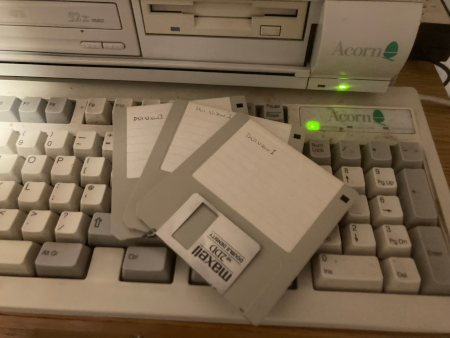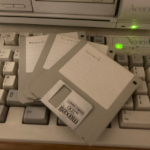Dickimaw Books Blog 
The Problem of Name Clashes and Lost Resources for Digital Historians (RISC OS ARMTeX) 🔗

When I first saw armtex pop up on the CTAN announcements, it piqued my interest and triggered a moment of nostalgia because the first TeX distribution that I installed, back in 1992, was called ARMTeX. However, it turned out that the ArmTeX in the CTAN announcement (a system for writing Armenian with TeX and LaTeX, dating back to 1997) is completely unrelated to ARMTeX (a TeX distribution for the Acorn ARM powered computers).
There are a growing number of digital historians who are interested in documenting old computing systems from the twentieth century, but much of the information has been lost. The Internet Archive’s Wayback Machine goes back to around 1995. For reference, the World Wide Web was created in 1989, Usenet in 1980, and FTP in 1971.
Many of the operating systems developed last century had limited
resources and there were restrictions on the maximum length of
filenames and what characters were permitted. With short names and
search engines in their infancy, there are likely many name clashes
from that era, especially where the context was restricted to
geographical area or operating system. This makes it quite hard for
historians to search for an old application. In fact, searching for
armtex yields some completely unrelated businesses.
The ARMTeX distribution that I installed on my Acorn Archimedes
in 1992 (which had LaTeX 2.09) came with a DVI viewer called
!DVIview, and here we have a similar problem because searching for
dviview shows another application with the same name.
ARM is a RISC (Reduced Instruction Set Computer) architecture that was designed by Acorn Computers. The ARM acronym originally stood for Acorn RISC Machine and then Advanced RISC Machine. ARM split off from Acorn and is now ubiquitous in mobile devices. ARM is now commonly stylised in lowercase but here I’m using ARMTeX in order to distinguish it from the other ArmTeX. The Acorn Archimedes family of computers used Acorn’s ARM processors and ran RISC OS which replaced the earlier Arthur operating system.
Searching for RISC OS can produce results for the unrelated MIPS RISC/os UNIX operating system and the RISC-V architecture. With so many RISC-based architectures and operating systems, it’s not surprising that searching for RISC OS can end up with many false leads.
I used ARMTeX to write my PhD thesis, articles, slides for presentations, and early drafts of my novels. I started my PhD in 1991, but it was likely not until 1993 that I installed ARMTeX. (I know I used it for my first conference paper, published in August 1993.) I had first tried some word processors but I’d found them frustrating, particularly for the pages of mathematical workings that I needed to include in my thesis.
In addition to the usual advantages of LaTeX that are often cited (such as the typesetting quality and automation of cross-references and table of contents), there were two particular advantages over the word processors I had tried that are no longer as relevant to me today, given the advances in hardware. The first was the ability to split the document into separate chapters that could be included or skipped when working on a particular chapter, allowing a faster build speed. (I know this is a feature that is still used today, and I will still have chapters in separate files for very large or shared documents, but processors are significantly faster these days.)
The second advantage may seem a bit strange. Back then on RISC OS (and certain other operating systems) there was no “undelete” file function (no waste-basket, recycle bin or whatever) nor did I have an “are you sure you want to delete” confirmation prompt. (I’ve only just found out that apparently this was a configurable setting that I hadn’t enabled. 🤦) I learnt to backup the hard way. It’s a bit of a heart-stopping moment when you realise you’ve just accidentally deleted the directory containing your PhD thesis. It wasn’t even the first time something like that had happened, as a draft of one of my novels (an early version of The Fourth Protectorate) had gone the same way. In both cases, the file content was retrieved by dumping the entire free space of the hard disc, filtering out all control codes and sifting through the remaining plain text manually. This was feasible for a 32Mb drive, but for a modern 1Tb or 2Tb drive a recovery tool would be needed instead. The incident with the novel was when I was still trying a word processor and all the formatting was lost when the control codes were stripped. However, the thesis was in LaTeX so all the document source code was recovered (but not the images). It’s not an advantage that I tout these days. I now use version control (and the plain text document source lends itself well to this).
This first installation of ARMTeX had LaTeX 2.09, which meant there were no
cls class files. Instead of the newer
LaTeX2e \documentclass and \usepackage
commands, it had the old \documentstyle command
with just sty style files. The main style
file was listed in the mandatory argument and the supplementary
style files were listed in the optional argument.
(On the flip side, although discovering old pages is an advantage for archivists,
it can be problematic if you’re searching for information on how to use the latest
version of something. If you come across a LaTeX tutorial that has \documentstyle
in the examples, then it’s very out-of-date.)
There were many competing operating systems in the twentieth
century, each with their own idiosyncratic filing system.
DOS used a backslash \ as the directory divider, and filenames were
case-insensitive (but usually displayed in all-caps) and
restricted to a maximum of eight characters before a dot and three after.
(For example, an executable file might be called LATEX.EXE.)
The absolute path started with the drive name followed by a colon.
(For example, C:\MYFILES\THESIS.TEX may be a plain TeX or LaTeX file.)
The Unix-like systems have a forward slash / as the directory divider
and file permissions determine whether or not the file can be run.
(For example, a file called latex with the executable bit set
is an application.) The filenames are case-sensitive and the absolute path
starts with a forward slash.
(For example, /home/myname/documents/thesis.tex may be a plain TeX or LaTeX file.)
On RISC OS, the directory divider is a dot and there were no file
extensions. The file type was set using a numeric value or (if
recognised) a textual synonym. The root directory is denoted with a
dollar sign $ and an absolute path name would start
with the filing system (such as ADFS) followed by two colons
(::), followed by the drive and a dot (for example,
4.) and then the path starting with the root directory.
(For example, ADFS::4.$.docs.thesis.tex is a file called
tex which would need to have its type set to the hexadecimal value
&2A8.) The maximum length of a RISC OS filename was 10 characters. (This was increased in
later RISC OS releases.)
A RISC OS file is identified as an executable if it has an executable file type. For example, the Obey file type indicates a script. More complex applications are bundled in an application directory, which is identified as such by an exclamation mark at the start of the directory name. For example, the vector graphics application bundled with RISC OS is called !Draw (pronounced pling draw). If you double-click on the application directory’s icon in the filer, it will run a special !Run file inside the directory rather than opening the directory. (The directory can be opened with shift double-click instead.) The application directory also contains a file called !Sprites which provides the directory’s icon image, which distinguishes it from a normal directory. There is also a special file called !Boot inside the application directory which automatically sets up applicable environment variables.
The directory divider dot made it a bit awkward porting files over from another system. The Archimedes could read an MS-DOS formatted floppy disc but it would display the dot in file extensions as a forward slash. So the THESIS.TEX file on an MS-DOS disc would display in the RISC OS filer as THESIS/TEX. Since eight dot three filenames consist of 12 characters in total, which exceeded the (at that time) 10 character maximum, the extension part could end up truncated. For example, the MS-DOS file MYTHESIS.TEX would display as MYTHESIS/T. Either way, the extension is irrelevant to RISC OS, except when converting between filing systems.
This meant it was problematic porting applications that required file extensions. For my PhD, I implemented
various algorithms in C, but I wrote, compiled and ran those applications on
RISC OS. In order to deal with the problem of the dot as a directory
divider, the C compiler flipped the file references round. For
example, #include "mylib.h" would be interpreted as the
file h.mylib, which refers to a file called
mylib contained in a directory called
h. There were similarly directories called
c and o.
The ARMTeX distribution dealt with the problem in a different
way. My LaTeX document thesis.tex
was a file called tex in
a directory called thesis.
The ARMTeX LaTeX would then create files called
dvi,
log,
aux, etc in that
thesis directory (with the file types set appropriately).
The \include commands in the tex file reference
the directories that have the same parent as the main thesis directory.
Each of those directories have a tex file (and will also have an aux file created in them).
![[Image: RISC OS filer windows and window showing LaTeX document source.]](/images/blog/risco-os-thesis-screenshot.png)
Note that this was before PDFTeX and long before XeTeX and
LuaTeX. The only output format was DVI. Images were included
with \special. The format was the Archimedes’ native
DrawFile format (created with !Draw). The !DVIview application was able to interpret
these specials and render the image.
The image dimensions were required in order to make sufficient space on the page for the image. For example, the following line
is in my PhD thesis source code:
\drawfile{4.053885in}{2.227235in}{@.diagrams.quadsizeex}
This references a DrawFile called quadsizeex
in diagrams, which is a subdirectory of
the document’s main directory. The \drawfile command
is defined in the document preamble:
\newcommand{\drawfile}[3]{\makebox[#1][l]{\rule[-#2]{0mm}{#2}\special{drawfile = #3}}}
Given that the dimensions in each \drawfile command have six
decimal places, I doubt I measured them manually.
I remember that the C code I wrote automatically generated DrawFile images of the results so I’m guessing
that there was a DrawFile library.
ARMTeX was updated to LaTeX2e, but I was a late adopter as it was too large to install on my 32Mb hard drive. My husband bought a RiscPC in 1997 which had more space and we were able to install the new version on that, but eventually I got a Linux laptop and switched over to teTeX (and later TeX Live).
My son, Cameron, grew up with our old Acorn computers and learnt to program on his dad’s RiscPC. Cameron discovered some of my old files, including a copy of datetime.dtx and datetime.ins dated 2004, probsoln.dtx and probsoln.ins dated 2000, and csvtools.sty dated 2003 (missing its original dtx and ins files from which it was generated). There are also other personal packages that I never uploaded to CTAN, as well as the source code for various documents, including my PhD thesis and the LaTeX tutorials I taught for postgraduates and staff (from which my LaTeX series developed).
It’s unlikely that ARMTeX will ever be resurrected, but it was an interesting trip down memory lane. After reading the draft of this post, Cameron started investigating TeX on RISC OS, and he will provide a follow-up detailing his findings. (One of the things we discovered is that there is actually a copy of ARMTeX on CTAN in the obsolete/systems/acorn directory, but more on this in the next post.)
Next Post
Previous Post
 The DRM-free ebook retailer SmashWords has its annual Summer/Winter sale from 1st – 31st July 2025. My crime novel “The Private Enemy” and children’s illustrated story “The Foolish Hedgehog” both have a 50% discount, and my crime fiction short stories “I’ve Heard the Mermaid Sing”, “Unsocial Media”, “Smile for the Camera”, and “The Briefcase” have a 100% discount (i.e. free!) for the duration of the sale. Did you know that you can gift ebooks on SmashWords?
The DRM-free ebook retailer SmashWords has its annual Summer/Winter sale from 1st – 31st July 2025. My crime novel “The Private Enemy” and children’s illustrated story “The Foolish Hedgehog” both have a 50% discount, and my crime fiction short stories “I’ve Heard the Mermaid Sing”, “Unsocial Media”, “Smile for the Camera”, and “The Briefcase” have a 100% discount (i.e. free!) for the duration of the sale. Did you know that you can gift ebooks on SmashWords?Recent Posts
 There are a growing number of digital historians who are interested in documenting old computing systems from the twentieth century, but much of the information has been lost and coincident names can make it hard to search. This article is about the RISC OS ARMTeX distribution, which provided TeX and LaTeX for the ARM-powered Acorn computers in the 1990s.
There are a growing number of digital historians who are interested in documenting old computing systems from the twentieth century, but much of the information has been lost and coincident names can make it hard to search. This article is about the RISC OS ARMTeX distribution, which provided TeX and LaTeX for the ARM-powered Acorn computers in the 1990s. The DRM-free ebook retailer SmashWords has its annual Summer/Winter sale from 1st – 31st July 2025. My crime novel “The Private Enemy” and children’s illustrated story “The Foolish Hedgehog” both have a 50% discount, and my crime fiction short stories “I’ve Heard the Mermaid Sing”, “Unsocial Media”, “Smile for the Camera”, and “The Briefcase” have a 100% discount (i.e. free!) for the duration of the sale. Did you know that you can gift ebooks on SmashWords?
The DRM-free ebook retailer SmashWords has its annual Summer/Winter sale from 1st – 31st July 2025. My crime novel “The Private Enemy” and children’s illustrated story “The Foolish Hedgehog” both have a 50% discount, and my crime fiction short stories “I’ve Heard the Mermaid Sing”, “Unsocial Media”, “Smile for the Camera”, and “The Briefcase” have a 100% discount (i.e. free!) for the duration of the sale. Did you know that you can gift ebooks on SmashWords? If you have read my short story Smile for the Camera, did you notice that the ending could have two possible interpretations? (No spoilers please!) As a writer, it’s always difficult to tell if something is too obvious or too obscure. If you need a hint, consider the naming scheme and remember that not everyone is what they say or imply that they are.
If you have read my short story Smile for the Camera, did you notice that the ending could have two possible interpretations? (No spoilers please!) As a writer, it’s always difficult to tell if something is too obvious or too obscure. If you need a hint, consider the naming scheme and remember that not everyone is what they say or imply that they are. The Ex-Cathedra writing group were delighted to present a cheque for £1,400 to St Martins Housing Trust during their collection at Tesco Harford Bridge on 6th December 2024. The money was raised from sales of the book Tales for Our Times, an anthology of short stories written by the group. The cheque was received by Ian Hanwell on behalf of St Martins. Many thanks to the support of everyone who purchased a copy and to the staff at Tesco Harford Bridge for allowing us to make the presentation there.
The Ex-Cathedra writing group were delighted to present a cheque for £1,400 to St Martins Housing Trust during their collection at Tesco Harford Bridge on 6th December 2024. The money was raised from sales of the book Tales for Our Times, an anthology of short stories written by the group. The cheque was received by Ian Hanwell on behalf of St Martins. Many thanks to the support of everyone who purchased a copy and to the staff at Tesco Harford Bridge for allowing us to make the presentation there. Search Blog
📂 Categories
- Autism
- Books
- Children’s Illustrated Fiction
- Illustrated fiction for young children: The Foolish Hedgehog and Quack, Quack, Quack. Give My Hat Back!
- Creative Writing
- The art of writing fiction, inspiration and themes.
- Crime Fiction
- The crime fiction category covers the crime novels The Private Enemy and The Fourth Protectorate and also the crime short stories I’ve Heard the Mermaid Sing and I’ve Heard the Mermaid Sing.
- Fiction
- Fiction books and other stories.
- Language
- Natural languages including regional dialects.
- (La)TeX
- The TeX typesetting system in general or the LaTeX format in particular.
- Music
- Norfolk
- This category is about the county of Norfolk in East Anglia (the eastern bulgy bit of England). It’s where The Private Enemy is set and is also where the author lives.
- RISC OS
- An operating system created by Acorn Computers in the late 1980s and 1990s.
- Security
- Site
- Information about the Dickimaw Books site.
- Software
- Open source software written by Nicola Talbot, which usually has some connection to (La)TeX.
- Speculative Fiction
- The speculative fiction category includes the novel The Private Enemy (set in the future), the alternative history novel The Fourth Protectorate, and the fantasy novel Muirgealia.
🔖 Tags
- Account
- Alternative History
- Sub-genre of speculative fiction, alternative history is “what if?” fiction.
- book samples
- Bots
- Conservation of Detail
- A part of the creative writing process, conservation of detail essentially means that only significant information should be added to a work of fiction.
- Cookies
- Information about the site cookies.
- Dialect
- Regional dialects, in particular the Norfolk dialect.
- Docker
- Education
- The education system.
- Ex-Cathedra
- A Norfolk-based writing group.
- Fantasy
- Sub-genre of speculative fiction involving magical elements.
- File formats
- Hippochette
- A pochette (pocket violin) with a hippo headpiece.
- History
- I’ve Heard the Mermaid Sing
- A crime fiction short story (available as an ebook) set in the late 1920s on the RMS Aquitania. See the story’s main page for further details.
- Inspirations
- The little things that inspired the author’s stories.
- Linux
- Migration
- Posts about the website migration.
- Muirgealia
- A fantasy novel. See the book’s main page for further details.
- News
- Notifications
- Online Store
- Posts about the Dickimaw Books store.
- Quack, Quack, Quack. Give My Hat Back!
- Information about the illustrated children’s book. See the book’s main page for further details.
- Re-published
- Articles that were previously published elsewhere and reproduced on this blog in order to collect them all together in one place.
- Sale
- Posts about sales that are running or are pending at the time of the post.
- Site settings
- Information about the site settings.
- Smile for the Camera
- A cybercrime short story about CCTV operator monitoring a store’s self-service tills who sees too much information.
- Story creation
- The process of creating stories.
- TeX Live
- The Briefcase
- A crime fiction short story (available as an ebook). See the story’s main page for further details.
- The Foolish Hedgehog
- Information about the illustrated children’s book. See the book’s main page for further details.
- The Fourth Protectorate
- Alternative history novel set in 1980s/90s London. See the book’s main page for further details.
- The Private Enemy
- A crime/speculative fiction novel set in a future Norfolk run by gangsters. See the book’s main page for further details.
- Unsocial Media
- A cybercrime fiction short story (available as an ebook). See the story’s main page for further details.
- World Book Day
- World Book Day (UK and Ireland) is an annual charity event held in the United Kingdom and the Republic of Ireland on the first Thursday in March. It’s a local version of the global UNESCO World Book Day.
- World Homeless Day
- World Homeless Day is marked every year on 10 October to draw attention to the needs of people experiencing homelessness.

